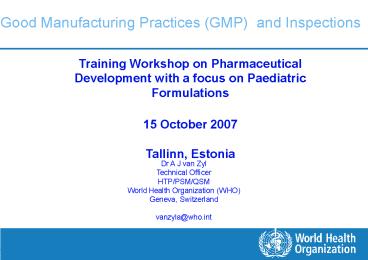Basic Principles of GMP - PowerPoint PPT Presentation
1 / 56
Title:
Basic Principles of GMP
Description:
Training Workshop on Pharmaceutical Development with a focus on Paediatric Formulations 15 ... ICH Q9 USA FDA Guidelines ... inspection and quality ... – PowerPoint PPT presentation
Number of Views:651
Avg rating:3.0/5.0
Title: Basic Principles of GMP
1
Good Manufacturing Practices (GMP) and
Inspections
Training Workshop on Pharmaceutical Development
with a focus on Paediatric Formulations 15
October 2007 Tallinn, Estonia
Dr A J van Zyl Technical Officer HTP/PSM/QSM World
Health Organization (WHO) Geneva,
Switzerland vanzyla_at_who.int
1
2
Good Manufacturing Practices (GMP) and
Inspections
- Outline and Objectives of presentation
- Introduce WHO GMP texts
- Main principles
- Supplements
- Others
- In the context of Prequalification
- Current and future approaches
- Inspections in prequalification
3
Good Manufacturing Practices (GMP) and
Inspections
- WHO GMP text Main principles
- WHO Technical Report Series, No. 908, 2003
- Annex 4
- Regularly reviewed and updated
- Divided into "chapters" or "quality systems"
- Quality assurance,
4
Good Manufacturing Practices (GMP) and
Inspections
- 1. Quality assurance
- 2. Good manufacturing practices for
pharmaceutical products (GMP) - 3. Sanitation and hygiene
- 4. Qualification and validation
- 5. Complaints
- 6. Product recalls
- 7. Contract production and analysis
- 8. Self-inspection and quality audits
5
Good Manufacturing Practices (GMP) and
Inspections
- 9. Personnel
- 10. Training
- 11. Personal hygiene
- 12. Premises
- 13. Equipment
- 14. Materials
- 15. Documentation
- 16. Good practices in production
- 17. Good practices in quality control
6
Good Manufacturing Practices (GMP) and
Inspections
- Other texts
- Sterile products
- Herbal medicines
- Radiopharmaceuticals
- HVAC
- Water systems
- Sampling etc
7
Good Manufacturing Practices (GMP) and
Inspections
- Also to consider when necessary
- PIC/S guidelines
- ISO guidelines
- Sampling
- Risk management
- Clean rooms
- ICH guidelines
- ICH Q9
- USA FDA
- Guidelines and guidance
8
Good Manufacturing Practices (GMP) and
Inspections
- Context in Prequalification
- Product specific (dosage form) inspections
- SOPs followed
- Planning, preparation, conduct, report
- Inspection team
- Appropriate guidelines used
- Report with references to text, and rating
- Critical, major, minor
9
Good Manufacturing Practices (GMP) and
Inspections
- A critical deficiency was defined as a deficiency
which had produced, or led to a significant risk
of producing, either a product which was harmful
to the human patient or a product which could
result in a harmful residue in a food producing
animal. - A major deficiency was defined as a non-critical
deficiency, which had produced or might produce a
product which did not comply with its marketing
authorisation. - A minor deficiency was defined as a deficiency
where an observation made could improve the
quality system and quality assurance approach of
the manufacturer, but which did not have a major
impact on the quality of the product.
10
Good Manufacturing Practices (GMP) and
Inspections
- Inspection approach
- Normally a "routine type" of GMP inspection
- Opening meeting, follow the flow, closing meeting
- On site inspection (production and quality
control) and documentation review - Quality systems approach
- Modern challenges including risk assessment
11
Good Manufacturing Practices (GMP) and
Inspections
- Guiding principles
- Risk based orientation
- Science based policies and standards
- Integrated quality systems
- International standards
- Public interest
12
Good Manufacturing Practices (GMP) and
Inspections
- Product quality and performance ensured through
- design (manufacturing processes)
- Product and process specifications
- Understanding of affect of formulation and
process factors on product quality and
performance - Quality by design (build quality into the
product) - Interaction between review, compliance and
inspection
13
Good Manufacturing Practices (GMP) and
Inspections
- Where to start?
14
Premises
- Principle
- Important aspects to be kept in mind to ensure
the suitability of - the operations to be carried out for different
dosage forms and - product range
- Location
- Design
- Construction
- Adaptation
- Maintenance
12.1
15
Premises
- Principle
- Premises must be located to minimize risks of
cross-contamination, e.g. not located next to a
malting factory with high airborne levels of yeast
12.4
16
Premises
- General
- The layout and design should aim to
- Minimize risks of errors
- Permit effective cleaning
- Permit effective maintenance
- Avoid cross-contamination, build-up of dirt
and dust - Avoid any adverse effect on the quality of
products
12.2
17
Premises
- Design Principles
- Keep in mind
- Material flow
- People flow
- Process flow
- Ensure logical flow
12.10
18
Premises
- Example of Materials and People Flow
- Arrival of goods Entrance for visitors
Entrance for Workers Shipment of goods -
-
Material Flow -
People Flow -
Zone Clean -
Zone Packaging -
Zone Controlled -
-
19
Premises
- Construction
- Suitable materials
- Electrical supply
- Suitable lighting (especially for visual on-line
checks) - Temperature and relative humidity control
- Appropriate and effective ventilation
- These may affect products during manufacture or
storage as well as functioning of equipment
12.8, 12.32
20
Premises
- The temperature and relative humidity should be
controlled, monitored in accordance with an SOP,
and the results recorded. The limits should be
appropriate according to the materials stored and
product processed
21
Premises
22
Premises
- Specific areas
- Review some recommendations for specific areas in
the following slides (Part 2) - Ancillary areas
- Storage areas
- Weighing areas
- Production areas
- Quality control areas
12.11































